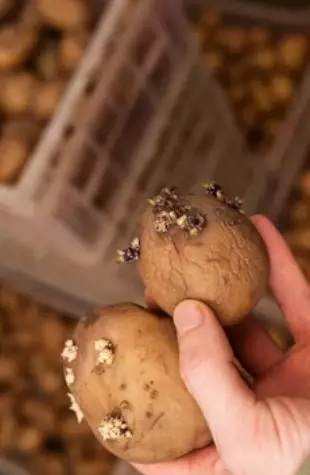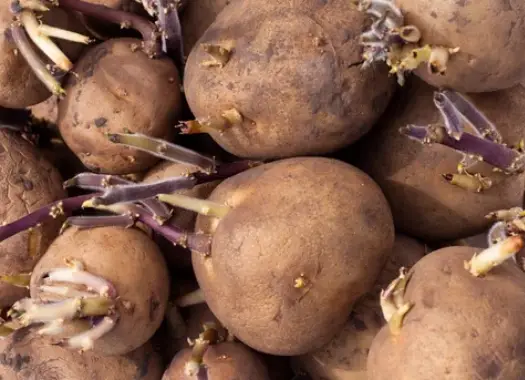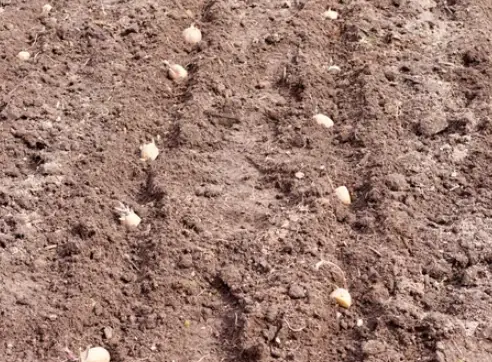Potatoes are a versatile and beloved vegetable, enjoyed by people all around the world.
Among the many different types of potatoes available, Yukon Gold potatoes are particularly popular due to their unique flavor and texture.
However, have you ever wondered about the origins of Yukon Gold potatoes, or how to plant and care for them in your own garden?
In this blog post, we will explore all things Yukon Gold potatoes seeds, from their history and characteristics to how to plant and care for them.
We’ll also share some delicious recipes to help you make the most of your Yukon Gold potato harvest. So, let’s dig in and discover the wonders of Yukon Gold potatoes!
What are Yukon Gold Potatoes Seeds?

Yukon Gold potatoes are a yellow-fleshed potato variety that is known for its smooth, buttery texture and rich flavor.
They are particularly popular for making mashed potatoes or roasted potatoes, but can also be used in a wide range of other dishes.
The Yukon Gold potato variety was first developed in the 1960s by a Canadian plant breeder named Garnet (“Gary”) Johnston.
Johnston was trying to create a potato variety that combined the best qualities of the North American white potato and the yellow-fleshed potatoes that were popular in Europe.
After several years of experimentation, he finally succeeded in creating the Yukon Gold potato.
Yukon Gold potatoes seeds are typically planted in the spring, once the soil has warmed up enough to allow for growth.
The seeds themselves are small, potato-shaped pieces of potato that have been cut from larger seed potatoes.
These seed potatoes are certified disease-free and have been carefully selected to produce the best quality Yukon Gold potatoes.
Once planted, Yukon Gold potatoes seeds will sprout and grow into potato plants that can produce a bountiful harvest of delicious potatoes.
With the right care and attention, you can enjoy fresh Yukon Gold potatoes straight from your own garden.
How long do Yukon gold potatoes take to Grow?

How to Plant Yukon Gold Potatoes Seeds

Planting Yukon Gold potatoes seeds is a relatively straightforward process, but it’s important to follow a few key steps to ensure the best possible results. Here’s a step-by-step guide to planting Yukon Gold potatoes seeds:
Choose a planting site
Yukon Gold potatoes prefer well-drained soil that is rich in organic matter. Choose a sunny location that gets at least six hours of direct sunlight each day.
Prepare the soil
Before planting, work plenty of compost or other organic matter into the soil to improve its fertility and structure. Remove any rocks or debris that could hinder growth.
Cut the seed potatoes:
Using a clean, sharp knife, cut your certified disease-free Yukon Gold seed potatoes into pieces that are approximately 2 inches in diameter. Each piece should have at least one “eye” or bud, which will sprout and grow into a new potato plant.
Let the cut potatoes dry
After cutting the seed potatoes, let them dry for a day or two in a cool, dry place. This will help to prevent rotting and improve their chances of sprouting.
Plant the seed potatoes
Dig a hole that is approximately 4-6 inches deep and place a seed potato piece in the hole with the eye facing up. Space each seed potato piece about 12 inches apart in rows that are 2-3 feet apart.
Cover the seed potatoes
Gently cover the seed potatoes with soil, making sure they are completely covered but not buried too deeply.
Water the seed potatoes
Water the newly planted seed potatoes thoroughly, and then keep the soil moist but not waterlogged throughout the growing season.
Wait for the plants to emerge
In a few weeks, the potato plants will begin to emerge from the soil. As the plants grow, you may need to hill up soil around the stems to prevent the potatoes from getting too much sun exposure.
With proper care and attention, your Yukon Gold potato plants should grow strong and healthy, producing a bountiful harvest of delicious potatoes with these steps.
Caring for Yukon Gold Potato Plants
Caring for Yukon Gold potato plants is relatively simple, but it’s important to provide them with the right conditions to ensure a healthy crop of potatoes. Here are some tips for caring for your Yukon Gold potato plants:
Watering
Potatoes need regular watering to grow well. Water your Yukon Gold potato plants deeply once a week, or more frequently if the weather is hot and dry. Avoid getting water on the leaves, as this can lead to disease.
Fertilizing
Yukon Gold potatoes need plenty of nutrients to grow well. Fertilize your plants with a balanced fertilizer when you plant them, and then again once the plants have started to grow. Avoid fertilizers that are high in nitrogen, as this can lead to lots of foliage growth but fewer potatoes.
Pest control
Yukon Gold potatoes are susceptible to a range of pests, including potato beetles, aphids, and wireworms.
Use insecticides sparingly and only as a last resort, as they can harm beneficial insects as well. Try to control pests naturally, by handpicking them off the plants or using organic pest control methods.
Disease control
Yukon Gold potatoes are susceptible to a range of diseases, including blight, scab, and rot.
Rotate your potato crops each year to avoid planting potatoes in the same spot twice, as this can lead to disease buildup. Also, plant certified disease-free seed potatoes to reduce the risk of infection.
Harvesting
Yukon Gold potatoes are ready to harvest when the foliage dies back and turns yellow.
Carefully dig up the potatoes using a spading fork, being careful not to damage them. Once harvested, allow the potatoes to dry in the sun for a day or two before storing them in a cool, dark place.
Recipes Using Yukon Gold Potatoes
Yukon Gold potatoes are a versatile ingredient that can be used in a wide range of dishes, from classic mashed potatoes to more creative recipes. Here are a few recipe ideas to try:
Roasted Yukon Gold Potatoes
Preheat your oven to 425 degrees F. Cut your Yukon Gold potatoes into bite-sized pieces and toss them with olive oil, salt, and pepper. Spread the potatoes out on a baking sheet and roast for 25-30 minutes, or until golden brown and crispy.
Yukon Gold Potato Salad
Boil your Yukon Gold potatoes until they are tender, then toss them with chopped celery, green onions, and a simple dressing of mayonnaise, mustard, and vinegar. Season with salt and pepper to taste.
Potato Leek Soup
Sauté chopped leeks in butter until soft, then add diced Yukon Gold potatoes and enough chicken or vegetable broth to cover. Simmer until the potatoes are tender, then puree the soup with an immersion blender until smooth. Season with salt and pepper to taste, and garnish with chopped fresh herbs.
Garlic Mashed Potatoes
Boil your Yukon Gold potatoes until they are tender, then mash them with butter, milk, minced garlic, and grated Parmesan cheese. Season with salt and pepper to taste, and serve hot.
Potato Crusted Quiche
Thinly slice your Yukon Gold potatoes and arrange them in a pie dish to form a crust. Beat together eggs, milk, grated cheese, and your favorite fillings (such as sautéed vegetables or cooked bacon), then pour the mixture over the potato crust. Bake at 350 degrees F for 30-40 minutes, or until the quiche is set and golden brown.
With their buttery flavor and smooth texture, Yukon Gold potatoes are the perfect ingredient for a wide range of delicious recipes.
Frequently Asked Questions:
Why are Yukon gold potatoes hard to find?
Yukon Gold potatoes are not necessarily hard to find, but they may be less commonly available in some areas compared to other potato varieties. There are a few potential reasons for this:
- Regional availability: Different potato varieties are more popular in different parts of the world, so the availability of Yukon Gold potatoes may be influenced by regional preferences.
- Farming practices: Yukon Gold potatoes require specific growing conditions, such as well-drained soil and plenty of sunlight. As a result, they may be more difficult to grow in some areas and less likely to be available from local farmers.
- Market demand: Some stores and supermarkets may choose to stock only the most popular potato varieties to meet the demands of their customers. This could mean that less common varieties like Yukon Gold potatoes are not always available.
Despite these potential challenges, Yukon Gold potatoes can usually be found at most supermarkets and grocery stores, especially those with a wide selection of products. They may also be available at local farmers’ markets or specialty food stores.
How many potatoes does a Yukon gold plant produce?
The number of potatoes that a Yukon Gold plant produces can vary depending on various factors such as the size of the seed potatoes used for planting, the growing conditions, and the care given to the plants.
Generally, each Yukon Gold plant can produce between 4-8 medium-sized potatoes, but it’s not uncommon for some plants to produce as few as 2 or as many as 10 potatoes.
It’s important to keep in mind that the yield can also vary depending on the spacing of the plants, the depth of the planting, and the amount of water and nutrients they receive.
With proper care, however, a single Yukon Gold plant can yield a decent harvest of flavorful and nutritious potatoes.
Where do Yukon Gold potatoes grow?
Yukon Gold potatoes can be grown in many different regions around the world.
Originally developed in Canada in the 1960s, they are well-suited to cooler climates with moderate rainfall and well-drained soil.
They are commonly grown in regions of North America such as the northeastern United States and Canada, as well as in areas of Europe and Asia.
In the United States, Yukon Gold potatoes are grown commercially in states such as Maine, Wisconsin, and North Dakota. They are also popular among home gardeners, who can grow them in backyard gardens or in containers on patios or balconies.
Because they are adaptable to a range of growing conditions, Yukon Gold potatoes can be grown in many different types of soil, from sandy loam to heavy clay.
They prefer cooler temperatures, with the ideal growing range being between 60-70 degrees Fahrenheit (15-21 degrees Celsius).
With proper care and attention, Yukon Gold potatoes can be a rewarding and delicious crop to grow in many different regions.
What is the best fertilizer for Yukon gold potatoes?
The best fertilizer for Yukon Gold potatoes is one that is balanced and contains a mix of essential nutrients.
When fertilizing potatoes, it’s important to provide sufficient amounts of nitrogen, phosphorus, and potassium to support healthy growth and a good yield.
One option for fertilizing Yukon Gold potatoes is to use a slow-release granular fertilizer that is specifically formulated for vegetable gardens.
These fertilizers typically contain a mix of nutrients that are released slowly over time, providing a steady supply of nutrients to the plants.
Another option is to use organic fertilizer, such as compost or well-rotted manure.
These fertilizers can provide a range of nutrients to the soil and help to improve soil structure and fertility over time.
When fertilizing Yukon Gold potatoes, it’s important to follow the manufacturer’s instructions for application rates and timing.
Generally, a balanced fertilizer should be applied at planting time and then again during the growing season, depending on the needs of the plants and the quality of the soil.
It’s important not to over-fertilize, as this can lead to excessive vegetative growth at the expense of the tubers.
Do potatoes need sun or shade to grow?
Potatoes need sunlight to grow, but too much direct sunlight can actually be harmful to the plants.
Ideally, potatoes should be planted in an area that receives partial to full sun, with at least six hours of direct sunlight each day.
Too much direct sunlight can cause the soil to dry out too quickly, which can stress the plants and lead to reduced yields.
It can also cause the leaves to wilt or burn, which can reduce the overall health of the plant and affect its ability to produce tubers.
On the other hand, too much shade can also be detrimental to potato growth.
Potatoes need sunlight to produce energy through photosynthesis, which is essential for the growth and development of the tubers. Inadequate sunlight can result in stunted growth, poor yield, and low-quality potatoes.
In summary, potatoes need sunlight to grow, but it’s important to find a balance between too much and too little sunlight to ensure optimal growth and yield.
What month do you plant potatoes?
The best time to plant potatoes depends on the climate in your region and the specific variety of potatoes you are planting.
Nonetheless, potatoes should be planted in the early spring, as soon as the soil has thawed and can be worked.
For most regions in North America, this means planting potatoes in March or April. In warmer climates, such as in the southern United States, potatoes can be planted in the late winter or early spring.
In cooler climates, such as in northern regions of the United States and Canada, potatoes may need to be planted later in the spring to avoid frost damage.
It’s important to note that potatoes can take several weeks to sprout and begin growing, so planting should be done well before the hottest part of the growing season to avoid heat stress on the plants.
Potatoes need consistent moisture throughout the growing season, so planting should be timed to ensure that the plants have access to adequate water.
Overall, the best time to plant potatoes is in the early spring, as soon as the soil is workable and temperatures are warm enough for the plants to begin growing.
Conclusion
Yukon Gold potatoes are a popular variety of potatoes known for their smooth, golden flesh and buttery flavor.
They are relatively easy to grow but require attention to certain factors such as soil, water, sunlight, and fertilizer to ensure a healthy crop.
With proper care, Yukon Gold potatoes can be a rewarding addition to any home garden and can be used in a wide variety of delicious recipes.
Whether you’re a seasoned gardener or a novice, planting and harvesting your own Yukon Gold potatoes can be a fun and satisfying experience.



